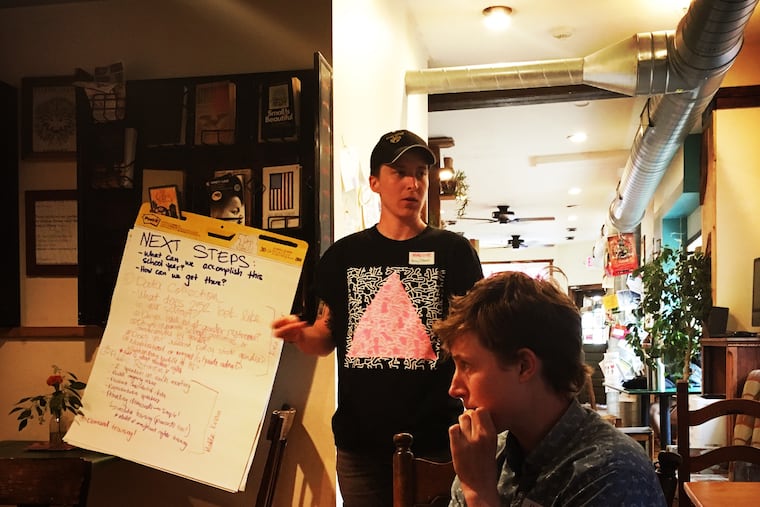Why I created a zine to support queer and trans students in the classroom | Opinion
As a Philly educator, I get to provide the support and guidance I so desperately needed as a young person.

It was February of my senior year at a Philly single-gender Archdiocesan Catholic school. My friends and I were looking forward to coasting through to June. With high school nearly over, all we worried about was prom and graduation.
During eighth period, the loudspeaker crackled. There would be an emergency faculty meeting after school. I knew instantly that I was the only item on the agenda.
That day, word had spread fast that I was circulating a petition in the senior class to change our prom rules. I was brave (foolish?) enough to ask why students had to bring a male date. We could not attend solo, in groups of friends, or in same-gender couples.
During that “emergency” meeting, in the process of warning teachers about the petition and making clear their commitment to the status quo, the administration outed me to the entire faculty. I had only previously come out to two teachers.
I’ve thought about this moment often in the years since. I share this anecdote whenever I present a workshop I developed called “Queering the Classroom Through Everyday Actions.” As a high schooler, I was devastated mostly because my petition failed. But in the process of becoming an educator, I’ve realized that my basic privacy rights as a student were violated by school leadership.
In summer 2016, I started my teacher certification program. I’d enter the classroom that September. Although I’d been working with young people since I was a kid myself, I grew anxious about being a queer educator. I wondered how to bring my queerness into my work, and if I would be supported in doing so. I wanted someone to tell me how and when to come out. When I searched for answers, I found there weren’t many.
While student teaching, I decided to experiment with steps toward a more queer-friendly classroom. This was partially selfish: I needed to ensure I’d have a long, successful career as a teacher. I also knew that LGBTQ+ students and allies would look to adults around them for a model.
This is my fourth year teaching at Kensington Health Sciences Academy. In that time, I’ve never stopped learning from my students. I’ve also gotten to know myself, developing from a closeted student teacher who identified as cisgender, to a proudly nonbinary queer teacher who uses the title “Mx.” (pronounced “mix”) and they/them pronouns.
Philadelphia has one of the nation’s most progressive policies for trans and gender-nonconforming students. This policy ensures that schools are gender-inclusive, from uniforms to bathroom facilities, and enumerates a student’s right to use gender-affirming name and pronouns in official documents. I’m fortunate that my own school community is welcoming and eager to grow. I have the support of my administration, colleagues, and students when navigating my identity in the classroom. This support applies to students, too, and they participate in our Queer-Straight Alliance and special events like Day of Silence to draw attention to the bullying and silencing of LGBTQ+ students.
However, such support is hardly standard across all schools. I’ve learned that although many teachers want to support LGBTQ+ students, they don’t know where to start. So I created my Queering the Classroom workshop, which I’ve presented over a dozen times to educators around Philadelphia. This summer, I made a zine to reach more educators, including ones outside the city.
I focus on three practical tips:
1. Address homophobic language in the classroom. Calling things “gay” or saying “pause” when a friend uses sexual innuendo are in students’ everyday lexicon. However, rather than call a student out for using harmful language, it’s important to call a student into ongoing, empathetic conversations that unpack the meaning of such terms.
2. Introduce queer-inclusive content early and often. Students should see themselves reflected in their learning material. Because I teach mostly Latinx and/or black students, I love to teach about queer leaders and artists like Bayard Rustin, Sylvia Ray Rivera, Frida Kahlo, and Pauli Murray.
3. Encourage students to ask questions, and take the lead when they need to learn. I encourage curiosity by finding appropriate and safe ways to talk about my experiences as a queer person. My partner comes to after-school events, and I’ve shared anecdotes about my high school experience. Students have become comfortable asking me questions.
When I was in high school, queerness was never mentioned except when labeled as sinful. There were no out teachers, and no space for open curiosity about identity, gender, and sexuality. Now I get to provide the things I so desperately needed as a young person, reaching students and building a network of educators confident about this work.
Maddie Luebbert is an English teacher at Kensington Health Sciences Academy, a fourth-generation educator, and lifelong Philadelphian. Luebbert facilitates the Queer Organizing Committee of the Caucus of Working Educators and co-founded the Conscious Classrooms and Communities Conference. @MaddieLuebbert